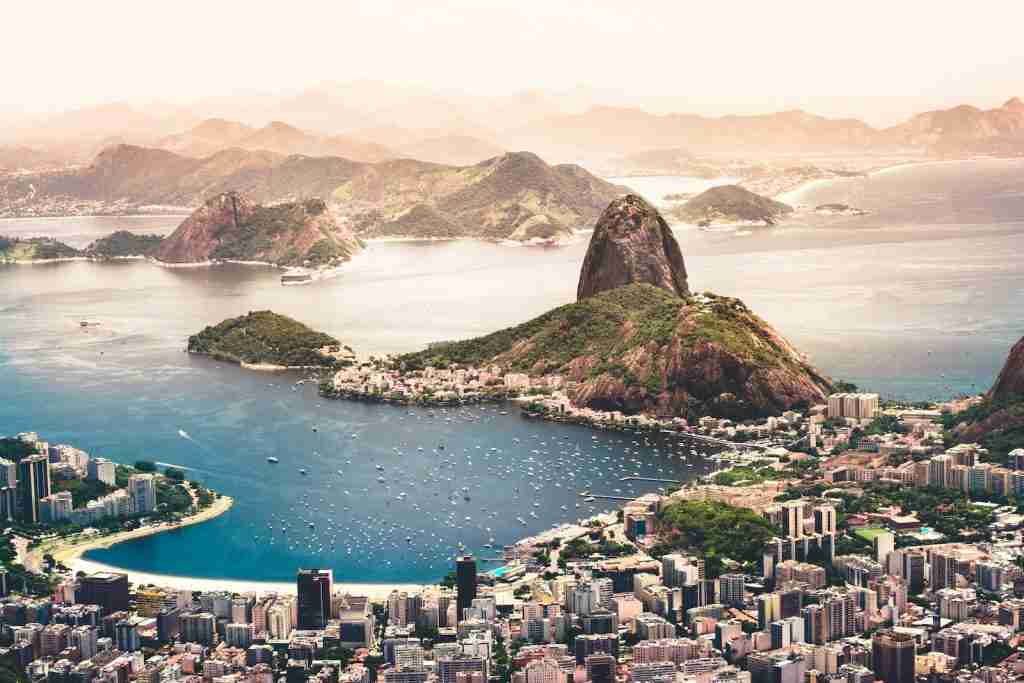25 Fun Facts About Brazil: Surprises You Never Expected
- Brazil was a colony of Portugal from the 16th century until its independence in 1822.
- Brazil’s population exceeds 210 million, making it the sixth-most populous country globally.
- Brazil’s Recife city is known as the Brazilian Venice due to its many bridges and canals.
- Brazil’s official national sport is not soccer but footvolley, a blend of football and volleyball.
- Brazil’s Santa Catarina state has some of the best surfing beaches in the world.
- Over 90% of Brazil’s residents can dance the Samba.
- Brazil’s São Paulo hosts the largest gay pride parade in the world.
- Brazil’s flag features 27 stars, representing the 26 states and the federal district.
- Brazil’s Atlantic Forest hosts 20,000 tree species, with 450 being endemic.
- The majority of Brazilians are Roman Catholic.
- Brazil has a unique time zone system, with four standard time zones across the country.
- Brazil predominantly has a tropical climate.
- Brazil’s Amazon Rainforest has a floating post office for remote communities.
- Brasília, the capital, was built in just four years.
- The name Brazil comes from the Brazilwood tree.
Table of Contents
1. Brazil is the largest country in South America.
When you look at a map of South America, you can’t miss Brazil. It’s massive, In fact, it’s the biggest country on the continent.
With its sprawling landscapes and diverse ecosystems, it covers a whopping 8.5 million square kilometers. That’s bigger than Australia.
2. Brazil shares its borders with every South American nation except Chile and Ecuador.
If you were to take a walk around South America, you’d find yourself crossing into Brazil a lot. Why? Because Brazil has neighbors all around.
It cozies up to every country in South America, except for Chile and Ecuador. So, imagine the countless cultural influences it shares and receives.
3. Brazil is home to the Amazon River, the world’s second-longest river.
Picture a river so vast, so mighty, that it’s second only to the Nile in length. That’s the Amazon River in Brazil.
Stretching over 4,000 miles, it’s not just a river it’s the lifeblood of the world’s most significant rainforest. The water carries a mix of stories, species, and secrets as it flows through Brazil’s heart.
4. Brazil has a total of 26 states and one federal district.

If you’re ever curious about how Brazil is organized, think of it like a puzzle with 27 pieces. There are 26 unique states, each with its own flair and flavor.
And then there’s the cherry on top Brasília, a federal district that’s also the capital of the nation.
5. Brazil’s Amazon Rainforest is home to one-tenth of all species in the world.
When you explore fun facts about Brazil, the Amazon Rainforest stands out like a beacon. It’s more than just trees and rivers it’s a bustling hub of biodiversity.
Astonishingly, one-tenth of all species in the world call this place home. From vivid butterflies to elusive mammals, the Amazon is a celebration of life on Earth.
6. Brazil has more than 4,000 airports.
Traveling around Brazil is quite a breeze, and here’s why the country boasts over 4,000 airports.
Whether you’re flying into vibrant cities or remote areas, Brazil has got you covered. That’s more airports than most countries in the world.
7. Brazil is home to the broadest road where 160 cars can drive side by side.
Imagine a road so vast that 160 cars could line up, shoulder to shoulder, and cruise along together. That’s not a scene from a sci-fi movie it’s a reality in Brazil.
The country brags the record for the world’s widest road, making it a paradise for those who love grand infrastructure.
8. Brazil’s São Paulo city has the largest economy by GDP in the Southern Hemisphere.

São Paulo isn’t just Brazil’s beating heart it’s also its economic powerhouse. With a GDP exceeding $700 billion, this lively metropolis holds the title of the largest economy by GDP in the Southern Hemisphere.
It’s a testament to São Paulo’s importance in global commerce and its standing as a vital financial hub.
9. Brazil is the world’s largest producer of coffee for over 150 years.
Morning rituals worldwide often start with a cup of coffee. And there’s a good chance that brew comes from Brazil.
The nation has been the globe’s top coffee producer for an astounding 150 years So, the next time you sip your java, remember the long journey it’s had, probably starting from a Brazilian coffee farm.
10. Brazil is the birthplace of Samba, Bossa Nova, and other influential music styles.
Brazil’s got a rhythm of its own, and the world loves to dance to it. This lively nation gifted us with Samba and Bossa Nova.
Picture the streets of Rio, dancers swaying, and those catchy tunes setting the pace. That’s Brazil’s musical heart echoing around the world.
11. Brazil’s voting system is completely digital.
Now, here’s something modern and impressive, In Brazil, when it’s time to vote, they don’t mark papers.
They tap screens. Brazil uses a completely digital voting system. It’s swift, it’s efficient, and it’s a glimpse into the future of elections.
12. Brazilians celebrate a version of Valentine’s Day on June 12.

In many corners of the world, folks exchange love notes and chocolates on February 14th. But Brazil dances to its own beat. There, the day to celebrate love is June 12th, called Dia dos Namorados.
Translated? It’s Sweetheart’s Day or Boyfriends’/Girlfriends’ Day. On this day, the air in Brazil is thick with romance, as lovebirds share special moments and tokens of affection.
13. Brazil has the world’s largest Japanese community outside Japan.
It’s a fun mix of cultures in Brazil. The country is home to the world’s largest Japanese community outside of Japan.
You’d find sushi spots, karaoke bars, and Japanese festivals, especially in São Paulo.
14. Brazil’s official language is Portuguese.
It’s easy to assume Spanish would be the dominant language in a South American giant like Brazil.
But history had other plans. Portugal, a European nation with its own global ambitions, colonized Brazil. Because of this, the Portuguese became the bedrock of communication in Brazil.
Today, while many neighboring countries communicate in Spanish, Brazil remains distinct, its voice echoing in Portuguese amidst the vast continent.
15. Brasília, the capital, resembles the shape of an airplane when viewed from above.
Brasília is more than just Brazil’s capital it’s an architectural wonder. Planned and developed in the 1950s, the city was designed by the acclaimed Brazilian architect Oscar Niemeyer and urban planner Lúcio Costa.
When seen from above, the city’s layout intriguingly mirrors the shape of an airplane, with its sectors and zones spreading out like wings.
16. Brazil has won the FIFA World Cup five times.
Soccer pulses in Brazil’s veins. Their national team’s prowess shines brightly with five FIFA World Cup victories under their belt. They claimed this coveted trophy in 1958, 1962, 1970, 1994, and 2002.
Each of these wins wasn’t just about the goals scored they were moments of national pride, celebrated by every Brazilian, young and old.
17. Brazil’s Christ the Redeemer statue in Rio de Janeiro weighs over 635 metric tons.
Constructed in 1931, Rio de Janeiro’s Christ the Redeemer statue stands as a cherished emblem for Brazil.
With a staggering weight of 635 metric tonnes, the monument rises to a height of 98 ft, its arms extending 92 ft wide. Recognized as one of the New Seven Wonders of the World.
18. Brazil has no desert, but the sertão region often experiences severe droughts.
Picture a country teeming with rainforests and rivers. Now, imagine an area in this same country, the sertão, facing severe droughts.
Although Brazil doesn’t have a desert, the sertão’s challenging conditions show the resilience and adaptability of its inhabitants.
19. Brazil’s highest point is Pico da Neblina, which stands at 9,827 feet.
Hiking enthusiasts take note, Brazil’s highest peak, Pico da Neblina, stands majestically at 9,827 feet.
Located near the Venezuelan border, this mountain challenges adventurers with its rugged terrains, all while offering breathtaking views that make the climb worth every step.
20. Brazil’s Carnival, a colossal event, draws millions of tourists worldwide.

If there’s one event that captures Brazil’s spirit and energy, it’s its Carnival. Renowned as the world’s largest celebration of its kind, streets burst into color, rhythm, and dance.
Tourists in millions flock to Brazil, fascinated by the allure of samba beats and vibrant parades.
21. Brazil has a coastline of 7,491 km, the 16th longest national coastline in the world.
Brazil’s natural beauty isn’t confined to its rainforests and mountains. The country boasts a staggering coastline of 7,491 km.
Ranking as the 16th longest in the world, this expansive stretch offers sandy beaches, coastal towns, and breathtaking views that beckon travelers and locals alike.
22. Brazil’s Itaipu Dam is one of the world’s largest hydroelectric power plants.
Brazil’s Itaipu Dam isn’t just a marvel of engineering it’s a powerhouse, quite literally. With a generating capacity of about 14,000 megawatts, this dam ranks among the world’s largest hydroelectric power plants.
In some years, it’s even surpassed the Three Gorges Dam in energy production.
23. One of the fun facts about Brazil is that Brazil has an island called Snake Island.
For those with a strong heart and a sense of adventure, Brazil’s Snake Island, or Ilha da Queimada Grande, is the stuff of legends.
It’s estimated that up to 4,000 golden lancehead vipers, one of the world’s most venomous snakes, inhabit this island. That’s about one snake for every square meter in some spots.
24. Brazil’s currency, the Real, was introduced in 1994 to stabilize the country’s economy.

Economic challenges in the 1990s led Brazil to introduce a new currency, the Real, in 1994. This move wasn’t merely symbolic within a year, inflation plummeted from nearly 2,500% to around 22%.
The Real played a pivotal role in stabilizing and strengthening Brazil’s economy.
25. Brazil has more species of monkeys than any other country in the world.
Brazil’s lush rainforests and diverse ecosystems are a playground for wildlife enthusiasts. Taking center stage among the myriad of animals are the monkeys.
With over 130 different species hopping around its vast landscape, Brazil proudly holds the record for the most diverse monkey population globally.
Whether it’s the howler monkeys echoing through the Amazon or the tiny marmosets navigating the treetops, Brazil is a primate paradise like no other.
FAQs
The main language of Brazil is Portuguese. It distinguishes Brazil from many of its South American neighbors, which primarily speak Spanish. This linguistic choice is rooted in the country’s colonial history under Portugal.
Brazil uses the Brazilian Real as its official currency. Introduced in 1994, it was pivotal in stabilizing the nation’s economy after a period of high inflation. The symbol for the Brazilian Real is R$.
The flag of Brazil is green with a large yellow diamond in the center, containing a blue circle with 27 small white stars arranged in the shape of the Southern Cross constellation. Inside the blue circle is a white band with the national mottoOrdem e Progresso, which means Order and Progress.
Brazil is a treasure trove of biodiversity, especially when it comes to fruits. Many fruits, such as açaí, umbu, guava, cerrado pear, and mapati, are native to Brazil. While some like guava have gained popularity globally, others remain local delicacies, showcasing the rich botanical heritage of this vast country.
Feijoada is hailed as Brazil’s national dish. This hearty stew, brimming with black beans, pork, and beef, encapsulates Brazilian culinary traditions. Often, it’s served with rice, collard greens, and slices of orange, making it a flavorful fusion loved by many.







